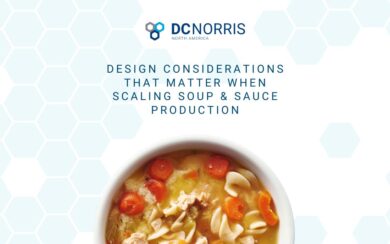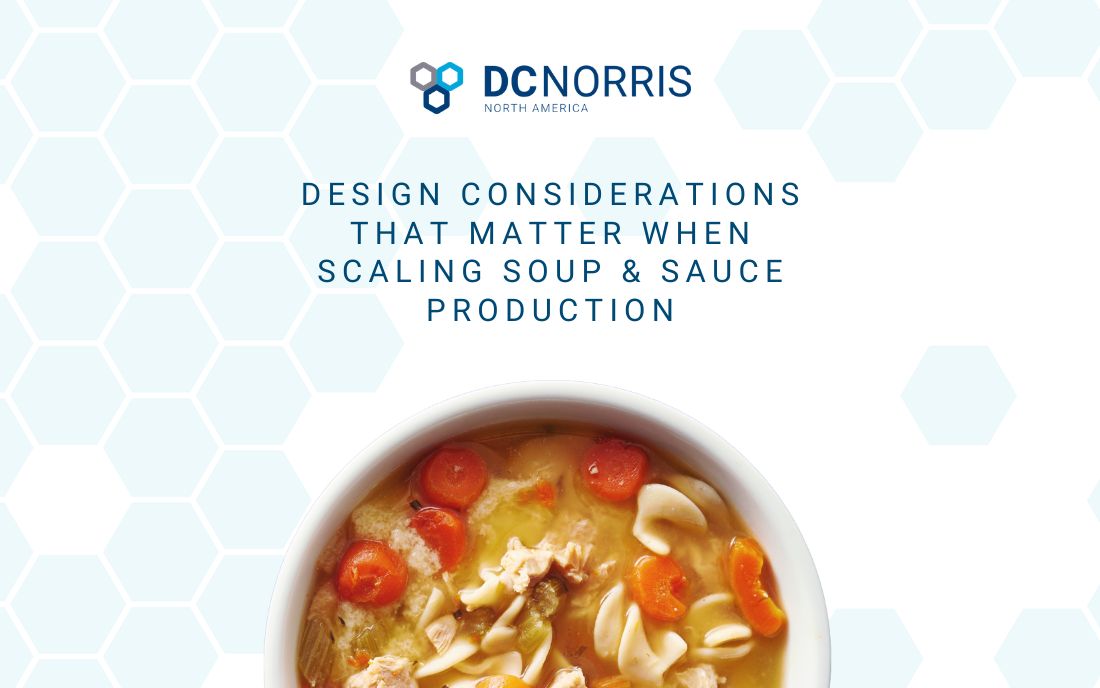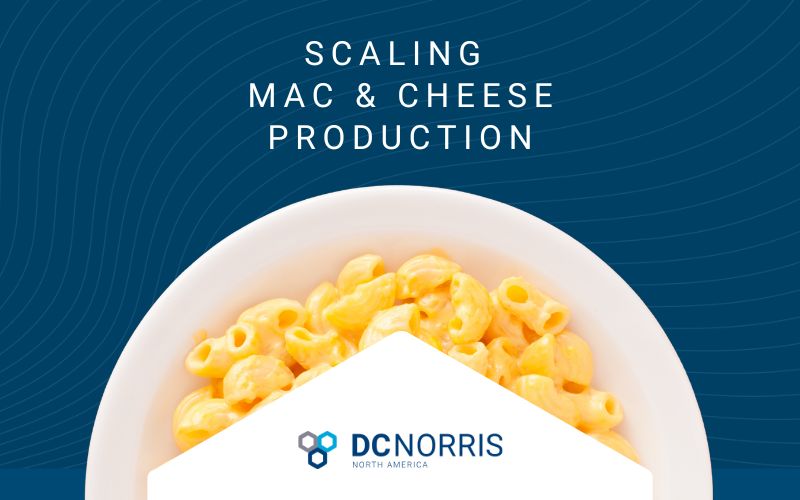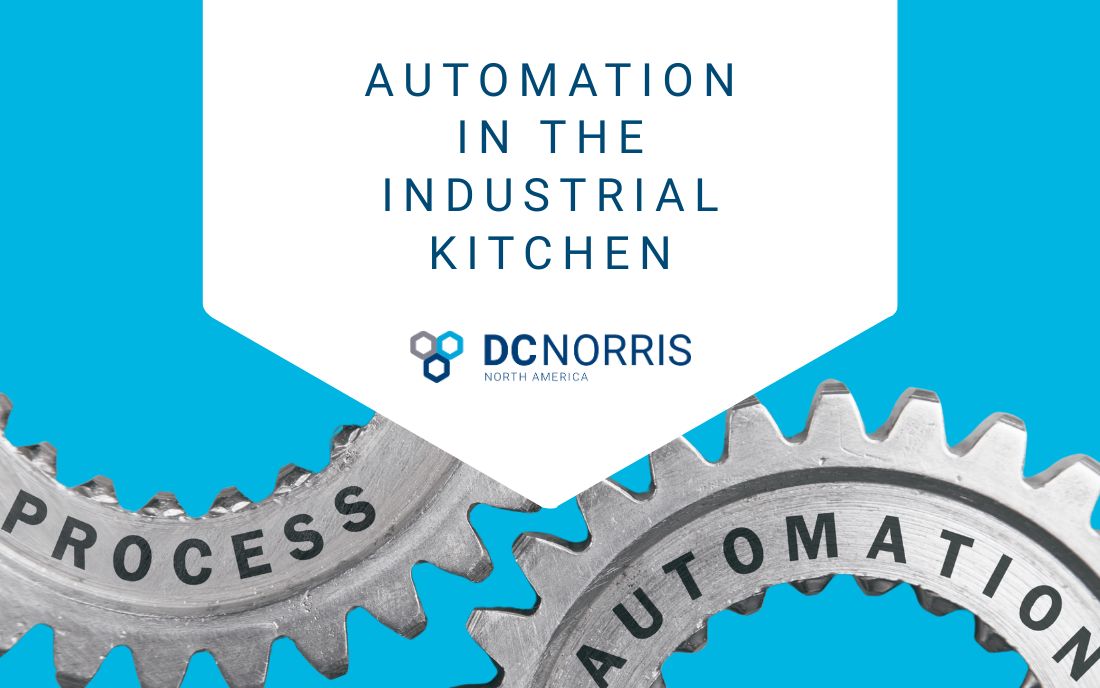 In this article:
In this article:
-
Scaling soup and sauce production isn’t just about bigger kettles. It requires precise engineering, product-specific equipment, and careful process design.
-
Thermal processing, agitation, and automation must be tailored to your product’s behavior to maintain quality and consistency at scale.
-
Choosing between batch and continuous systems, optimizing cooling and filling, and future-proofing your setup are critical to building a scalable, efficient operation.
Design Considerations That Matter When Scaling Soup & Sauce Production
As product quality and nutrition profiles improve, so too does consumer demand for ready-made soups, sauces, and heat-and-serve meals. While welcomed, this increase in demand puts manufacturers under pressure to scale production without sacrificing quality, consistency, or efficiency. Scaling soup production isn’t just about bigger kettles or faster lines. It requires careful planning, specialized equipment, engineering expertise, and a deep understanding of how ingredients behave at scale.
From ingredient prep to thermal processing and packaging, every step of the process must be engineered for repeatability, food safety, and throughput. In this post, we’ll explore the most critical design considerations for manufacturers looking to scale soup and sauce production successfully.
The Complexity of Scaling Soup Production
Scaling soup production is more complex than increasing batch size. What works in a test kitchen or pilot run can behave very differently at production volumes. Heat transfer, mixing dynamics, particulate integrity, and even cleaning protocols shift dramatically when moving from small-scale to industrial-scale production.
This is especially true for products with diverse ingredient types, like dairy-based soups, starch-thickened sauces, or products containing particulates such as beans, pasta, or meat. Scaling successfully requires a process designed not just for volume, but for product integrity at volume.
Equipment Selection Starts with Product Type
Not all soups and sauces are created equal, and neither is the equipment used to process them. The viscosity, particulate load, and thermal sensitivity of a product all influence equipment selection.
For smooth or emulsified products, such as tomato soup or cheese sauce, systems with high-shear mixing and efficient heat transfer, like the Jet Cook™ system, can dramatically improve cooking time and consistency.
For chunky or fragile products, such as chowders or bolognese-style sauces, low-shear agitation and gentle heat application are essential to prevent damage to particulates. In these cases, steam-jacketed kettles with agitation or combination systems are ideal.
Key tip: Choose a system that matches your product’s behavior under heat, not just one that meets a volume requirement.
Heat Transfer Efficiency Impacts Speed and Safety
In soup and sauce production, time is temperature and temperature is safety. Poor heat distribution can create hot spots that burn product or cold zones, both of which compromise product quality and shelf stability.
When scaling up, manufacturers must account for how heat penetrates large batches. Direct steam-injection systems like Jet Cook™ can significantly speed up thermal processing, especially in high-viscosity formulations, by eliminating the need to heat through the kettle wall.
For traditional systems, optimizing jacket design, surface area, and agitation is critical. CIP (clean-in-place) considerations also factor into design, as residues from thickened or protein-rich products can lead to fouling or contamination risk.
Agitation and Mixing Design Must Protect Product Integrity
How a product is stirred or mixed can make or break its appearance and texture, especially when scaling up. Improper agitation at higher volumes can lead to particle damage, separation, or uneven cooking.
When scaling soup production, pay close attention to the agitation method:
- High-shear mixers are excellent for emulsification and rapid dispersion of powders or starches.
- Gentle agitators preserve large particulates and prevent sticking or scorching.
- Hybrid systems can be programmed to shift agitation speeds or styles depending on the stage of processing.
- Agitation should be designed to match both the flow characteristics of the soup and the size/structure of any inclusions.
Batch vs. Continuous: Choosing the Right Process Flow
One major decision when scaling soup production is whether to use a batch or continuous cooking model.
Batch systems offer flexibility and easier recipe changes but can be slower and require more downtime between runs.
Continuous systems are ideal for high-volume, standardized products and offer efficiency gains through steady-state operation.
Many manufacturers opt for semi-continuous setups with integrated cooking, holding, and cooling systems, balancing the advantages of both models. The right choice depends on your production targets, product variability, and available floor space.
Cooling and Filling Matter Just as Much as Cooking
Efficient cooling is often overlooked but is vital to preserving product integrity and safety post-cook. Rapid cooling helps extend shelf life, retain texture, and meet regulatory requirements.
Filling systems must also be selected based on product viscosity and particulate size. Piston fillers, rotary fillers, or mass flow systems should all be evaluated to ensure accurate portioning and minimal damage.
Automation, Data Capture & Repeatability
As production scales, manual intervention becomes a bottleneck and a risk. Automating key steps like cooking, mixing, CIP, and recipe management not only improves efficiency but ensures consistency.
Look for systems that offer:
- Recipe recall and sequencing
- Real-time temperature and flow monitoring
- Batch data logging for traceability
These capabilities are especially important when managing allergen protocols, regulatory audits, and brand-specific quality standards.
Future-Proofing for Flexibility and Growth
When scaling soup and sauce production, it’s wise to think beyond immediate demand. Flexible system design allows you to introduce new SKUs, adjust for ingredient shifts, and expand volume capacity over time.
That might mean investing in modular systems that can be upgraded later, building in extra CIP capacity, or designing around ingredients prone to change in price or supply chain availability.
Choosing the right equipment partner also matters. Work with suppliers who understand your product range, regulatory requirements, and growth goals and who can provide ongoing technical support as your operation evolves.
Build a Scalable Foundation, Not Just a Bigger Line
Scaling soup and sauce production requires more than increased volume; it takes a holistic process design built around the unique behavior of your product. From heating efficiency to mixing dynamics and packaging integration, every decision shapes the outcome.
By investing in experienced partners, proven systems, automation, and planning, you’ll be positioned not just for higher throughput but for long-term success in a competitive, quality-driven market.
Let’s Talk About Scaling Your Operation
If you’re exploring new production lines or upgrading your current facility, DC Norris North America can help. We’ve designed soup and sauce systems for startups and global brands alike, always with a focus on process precision and long-term scalability.
Contact us to schedule a consultation or learn more about our turnkey and modular cooking solutions.



